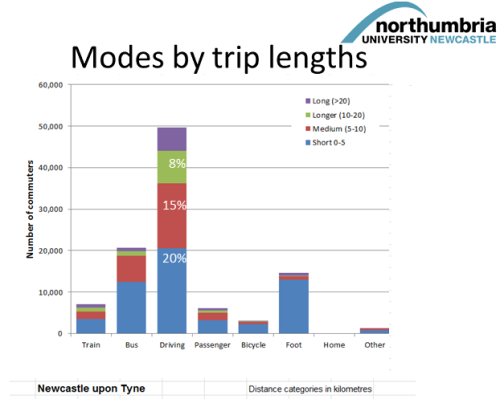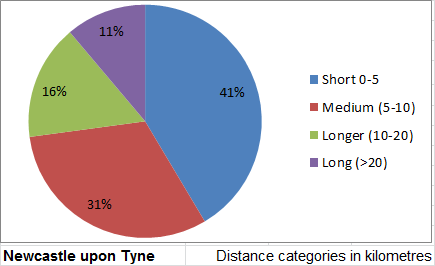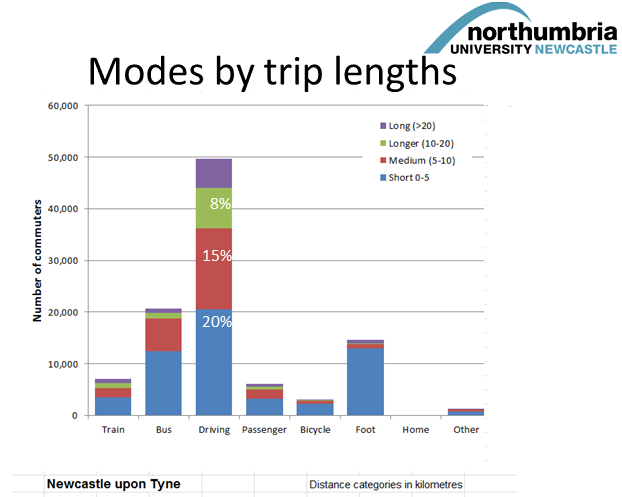Leading on from last week’s Census 2011 data analysis (see slideshare presentation embedded here), I’d like to highlight some of the key findings that would otherwise remain hidden away in the slides. This is important as the census data clearly demonstrates the enormous potential for reducing car use (ie mode shift).

Whilst the census data is solely concerned with commuting (rather than visiting friends, going to the shops etc), it is still worth noting and discussing – for it is the commute that stretches our road system to its spatial limits. In many ways addressing the car-based commute is at the epicentre of making mode shift happen.
When I mention mode-shifting potential, I really mean taking a good look at the short trips currently done by car. Whilst for some cycling is quite possible for longer commutes, a generally manageable distance for commuting could be defined as up to 10km, or just over 6 miles.
All commutes
- Nationally (England and Wales) 35% of all commutes of that cycleable distance are done by car. This amounts to over 7 million commuters who could be shifted away from car use
- At my city of work and play, Newcastle, although already quite a public transport city, nonetheless matches the 35% mode-shift category locally – amounting to over 35,000 car commuters that have the potential to switch to greener ways of travelling to work
Driving only
Another way of looking at this is to concentrate on the car-commuted journeys. Then a staggering
- 59% of national car commuters have a journey fewer than 10km
- 72% of Newcastle-originated car commuters have a journey fewer than 10km
Professionally speaking
Imagine the road space, currently taken up by driving and parking, that could be freed up during the ‘rush hour’ peaks. So what’s keeping us ditching our cars for short journeys? Well, we do know – from decades of trying – that people won’t just change. Warm words are not enough as Spotswood et al (2015) say, in a paraphrased way. It’s a societal-political problem. It needs institutional and structural response – it’s bigger than any one individual can solve.
A spatial problem can be solved through spatial means.
It’s about providing clear and attractive alternatives. The current city engineering and planning will have to adapt and apportion space according to the desired future mode share. A road diet is necessary, and long overdue in the UK. A new look at planning and engineering the transport networks is a must.
Politically speaking
What’s keeping us going on a transport transition (in a concerted and all-in-this-together kind of way) is politicians, policy- and decision-makers, engineers and planners – at national and local levels. It appears not all of these key people yet believe or are not yet convinced
- that mode shift works
- or even what mode shift is needed or what it means
- exactly how mode shift can be brought about
- that re-distributing urban space would be successful in getting people out of their cars
- that this is what their voters want
- that street designs inducing active travel is what people want
Academia and advocacy have their work cut out to spell answers out more clearly.
Fig 1 Mode-shift potential for England and Wales
Fig 2 Mode-shift potential in Newcastle
References
Spotswood, F., Chatterton, T., Tapp, A. and Williams, D. (accepted for publication) Analysing cycling as a social practice: An empirical grounding for behaviour change, Transport Research Part F






[…] press release) http://newcycling.org/value-current-cyclists-revealed/ Census data discussion https://katsdekker.wordpress.com/2015/07/03/it-makes-complete-common-census/ WHO heat tool http://www.heatwalkingcycling.org/ Children are our future […]
LikeLike